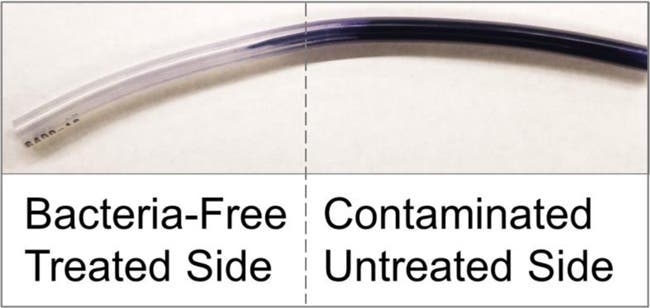A new liquid-infused polymer can make sure that medical equipment is bacteria free by being extremely slippery. This technology, which involves silicone infused with a silicone oil also has a myriad of potential applications outside of medical equipment – in the oil industry, in air planes and cosmetics.

According to the National Institutes of Health, over 80 percent of all infections in the human body are caused by a build-up of bacteria. Bacteria accumulates into adhesive colonies called biofilms, which help them survive and protect them from outside threats. Common soaps don’t actually destroy the bacteria, but they make a slippery surface on your skin making it so that bacteria can’t attach themselves to you and fall off – this is the main idea here too.
Such bacterial biofilms tend to form on medical equipment, including surgery equipment heart valves, urinary catheters, intravenous catheters, and implants. Naturally, we don’t want that to happen – as it can be extremely dangerous. Now, a new study demonstrated a long-lasting repellent surface technology that can be used with medical materials to prevent infections caused by biofilms.
The new technology (liquid-infused polymers) can store considerable amounts of lubricant in their molecular structure, much like a sponge holds liquids. This lubricant can then travel to the surface, repelling the bacterian and blocking the environment in which it forms. The team led by Joanna Aizenberg from Harvard is now working on designing several such liquid-infused polymer systems which could be applied on various medical surfaces. However, super-slippery surfaces can have applications in more fields, including keeping glass clean, making better cosmetics and ensuring that ice doesn’t stick to airplane wings.
For this study, they used both a silicone material, and a silicone oil, which are non toxic and safe to use.
“The solid silicone tubing is saturated with silicone oil, soaking it up into all of the tiny spaces in its molecular structure so that the two materials really become completely integrated into one,” said Caitlin Howell, a Postdoctoral Researcher at the Wyss Institute and a co-author on the new findings.
To test the effectiveness of the super slippery surface, the study’s lead author Noah MacCallum, an exchange undergraduate student at SEAS, exposed treated and untreated medical tubing to Pseudomonas aeruginosa, Escherichia coli, and Staphylococcus epidermidis, which are common pathogenic bacteria that form biofilms and are the most common culprits in blood and urinary infections. The experiment confirmed what scientists believed – that the surface greatly reduces biofilm adhesion and largely (though not totally) eliminated biofilm formation. The results give great hope for future applications and reducing infections, especially with drug-resistant bacteria.
“With widespread antibiotic resistance cropping up in many strains of infection-causing bacteria, developing out-of-the-box strategies to protect patients from bacterial biofilms has become a critical focus area for clinical researchers,” said Wyss Institute Founding Director Donald Ingber, who is also the Judah Folkman Professor of Vascular Biology at Harvard Medical School and Boston Children’s Hospital and Professor of Bioengineering at Harvard SEAS. “Liquid-infused polymers could be used to prevent biofilms from ever taking hold, potentially reducing rates of infection and therefore reducing dependence on antibiotic use.”
As for applying super-slippery surfaces to other fields, the authors have big plans.
. “We could apply liquid-infused polymers to other materials plagued with biofouling problems, such as waste-water management systems, maritime vessels or oil pipes,” said one of the study’s lead co-authors Philseok Kim, who was formerly a Senior Research Scientist at the Wyss Institute and is currently co-founder and Vice President of SLIPS Technologies, Inc.
However, before we can speak of actually implementing super slippery surfaces into waste water management or the oil industry, the technology has to prove its efficiency in experimental results. Still, the development shows great promise, and I’m certain we’ll be hearing more from it in the near future.
“Each technology in our portfolio has different properties and potential uses, but collectively this range of approaches to surface coatings can prevent a broad range of life-threatening problems, from ice accumulation on airplane wings to bacterial infections in the human body,” said Aizenberg.
Journal Reference: Noah MacCallum et al. Liquid-Infused Silicone As a Biofouling-Free Medical Material. DOI: 10.1021/ab5000578


